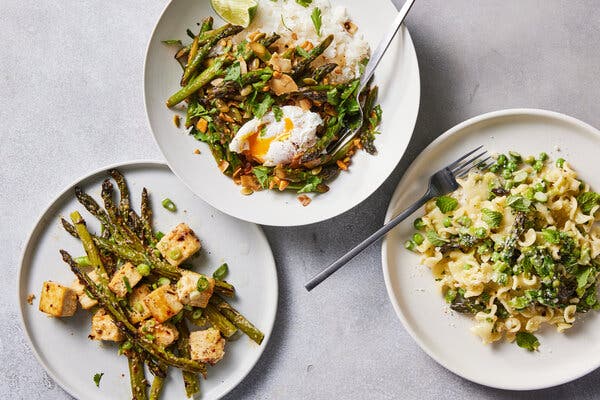A Good Appetite
You don’t just have to roast those stalks. These three easy techniques can bring out the delicious best from the spring favorite.
The first blush of asparagus season never gets old. Every April, seeing those violet-tipped bunches at the farmers’ market sends my pulse zipping and my mind whirling. Dreaming up new ways of preparing them is almost as thrilling as eating them, though clearly not as satiating.
Because asparagus cook so quickly and are delightful at any stage of doneness — crisp-tender, velvety soft and even raw, if very fresh — they take well to a host of techniques.
Lately, roasting has been my go-to. It’s not necessarily easier or faster than any other method, but I love how the oven’s heat intensifies asparagus’ flavors, caramelizing and sweetening the stalks while the tips get crispy. It’s also convenient. Asparagus roasts beautifully at any temperature from 375 degrees to 450 degrees, which means I can throw a pan of oiled, salted spears into the oven along with whatever else I’m making for dinner. Add a drizzle of yogurt or good olive oil, and some chopped herbs or scallions, and you get a nearly effortless side dish with charm and sophistication.
This spring, though, I wanted to focus on some other cooking techniques that would both highlight asparagus’s versatility and coax a wide range of qualities from the leaf-green stalks.
Broiling
I started with broiling, which is roasting-adjacent. But where roasting surrounds the stalks with relatively even and gentle heat, broiling blasts them fiercely and directly, singing them until blackened outside, tender and sweet within.
Broiled asparagus has an intense flavor, so I wanted to match it with a pungent sauce. While the spears were under the broiler, I whisked together a simple miso glaze, flavored with sake, mirin and sesame oil, and brushed it on during the last few minutes of cooking. To make the dish more substantial (and for a soft, mild contrast), I added tofu.
Thank you for your patience while we verify access.
